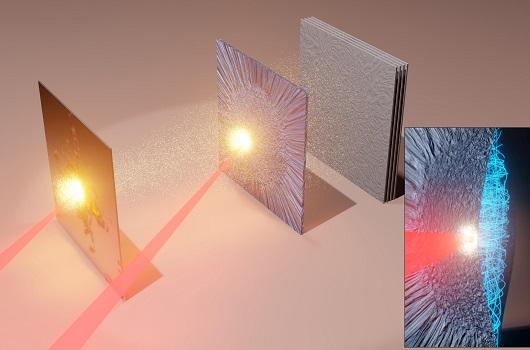An international team of researchers highlighted two variants of Weibel’s instability

Credit: David Tordeux
The magnetic structures resulting from a plasma instability predicted by the physicist Erich Weibel about 50 years ago has been evidenced at surprisingly large scales in a laser-driven plasma in the prestigious journal Nature Physics. This instability is also expected to operate in astrophysical settings where it is held responsible for the acceleration of cosmic rays and the emission of gamma photons in the famous “gamma-ray bursts”.
Julien Fuchs, a graduate of the Institut national de la recherche scientifique (INRS) and a researcher at the Laboratoire pour l’utilisation des lasers intenses (LULI) in France, INRS Professor Patrizio Antici, a specialist in laser-driven particle acceleration, and INRS Professor Emeritus Henri Pépin have succeeded in measuring the magnetic fields produced by Weibel instabilities within a laser-driven plasma, an ionized gas. Their results were published on June 1 in the prestigious journal Nature Physics.
The researchers used the proton radiography technique to visualize this extremely fast phenomenon. “Our protons accelerated by laser-plasma interaction are able to take a sequence of images of very fast electromagnetic phenomena, lasting a few picoseconds only and with a resolution of a few microns. This allows us to probe instabilities with precision unmatched by other imaging techniques” reports Patrizio Antici, who did his thesis under the supervision of Professor Fuchs, himself formerly under the direction of Professor Pépin.
These three generations of researchers recreated a “small-scale model” of astrophysical phenomena in the laboratory by irradiating a target with an intense laser. The magnetic fluctuations generated by the interaction can be probed by protons on a series of sensitive films, producing a sequence of images showing the temporal evolution of the magnetic structures.
The interpretation and modeling of these structures were conducted by Laurent Gremillet and Charles Ruyer, physicists at the Commissariat à l’énergie atomique et aux énergies alternatives (CEA). After several years of hard work, combining theoretical modelling and advanced numerical simulations, they highlighted the growth of two variants of the Weibel instability according to the region of the plasma where they develop.
With more powerful lasers, researchers will be able to reproduce and analyze even more extreme astrophysical phenomena with unrivalled resolution.
###
About the study
“Growth of concomitant laser-driven collisionless and resistive electron filamentation instabilities over large spatiotemporal scales” by C. Ruyer, S. Bolaños, B. Albertazzi, S. N. Chen, P. Antici, J. Böker, V. Dervieux, L. Lancia, M. Nakatsutsumi, L. Romagnani, R. Shepherd, M. Swantusch, M. Borghesi, O. Willi, H. Pépin, M. Starodubtsev, M. Grech, C. Riconda, L. Gremillet & J. Fuchs was published in Nature Physics. They have received financial support from the Horizon 2020 research and innovation programme of the European Union and the European Research Council (ERC). DOI: https://doi.org/10.1038/s41567-020-0913-x
About the INRS
The Institut National de la Recherche Scientifique (INRS) is the only institution in Québec dedicated exclusively to graduate level university research and training. The impacts of its faculty and students are felt around the world. INRS proudly contributes to societal progress in partnership with industry and community stakeholders, both through its discoveries and by training new researchers and technicians to deliver scientific, social, and technological breakthroughs in the future.
Contact:
Audrey-Maude Vézina
Service des communications et des relations gouvernementales de l’INRS
418-687-6403
[email protected]
Media Contact
Audrey-Maude Vezina
[email protected]
Original Source
http://www.
Related Journal Article
http://dx.




